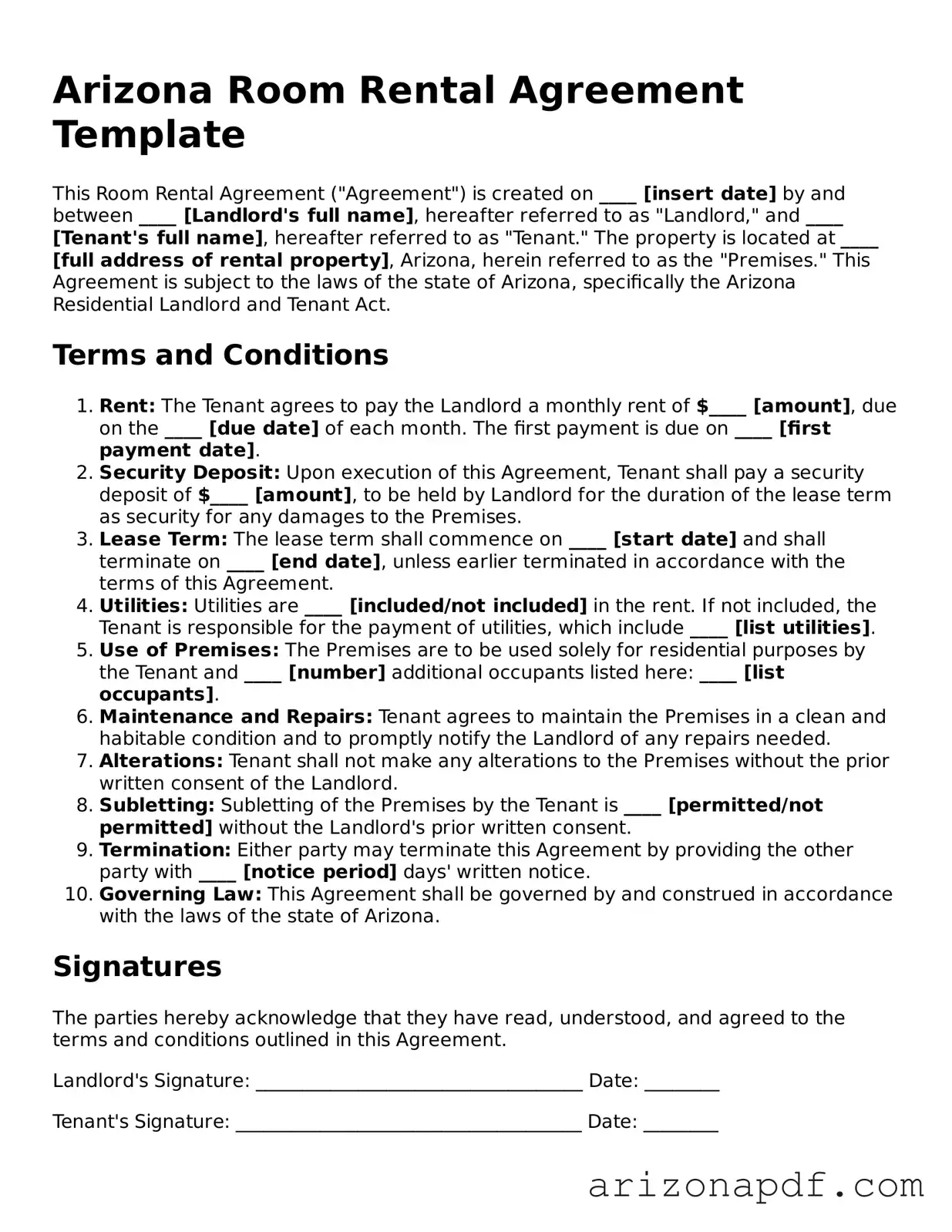What is the purpose of an Arizona Room Rental Agreement?
In Arizona, a Room Rental Agreement is used to outline the terms and conditions of renting a single room within a larger dwelling. It serves to establish a clear understanding between the property owner or principal tenant and the individual renting the room (roommate). This agreement covers aspects such as rent, utilities, shared spaces usage, and other important rules and expectations to ensure a harmonious living situation.
Who needs to sign the Arizona Room Rental Agreement?
The agreement must be signed by the landlord or principal tenant (the person who holds the lease to the property) and the tenant renting the room. In some cases, if the principal tenant is different from the property owner, it's advisable for the property owner to also be aware of and agree to the arrangement, although they might not sign the agreement themselves.
What should be included in this agreement?
An Arizona Room Rental Agreement should include details such as the duration of the rental term, monthly rent amount, security deposit details, utility payment responsibilities, rules regarding guests, maintenance responsibilities, and any specific policies about pets, smoking, or parking. It should clearly define which areas of the property are shared and which are private.
How long can a room rental agreement last in Arizona?
The duration of a room rental agreement in Arizona can vary to suit the needs of both parties. It can be fixed-term, typically for a period of 12 months, or on a month-to-month basis. The choice depends on the preferences of the landlord and the tenant, with month-to-month arrangements providing greater flexibility for both parties.
Can the terms of a Room Rental Agreement be modified?
Yes, the terms of a Room Rental Agreement can be modified, but any changes should be agreed upon by both the landlord and the tenant in writing. It is crucial for both parties to formally document these amendments to avoid any future disputes or misunderstandings.
What happens if a tenant violates the terms of the agreement?
If a tenant violates the terms of the Room Rental Agreement, the landlord has the right to take action in accordance with Arizona law. This might include giving the tenant a notice to cure the violation or, in severe cases, proceeding with eviction. The specific steps and remedies should be outlined in the agreement itself.
Is a security deposit required for a room rental agreement?
While Arizona law does not specifically require a security deposit for room rentals, many landlords choose to require one as a safeguard against potential damages or unpaid rent. The amount and terms of the security deposit should be clearly stated in the Room Rental Agreement.
How is rent determined and what does it typically cover?
Rent amounts are negotiated between the landlord and the tenant, taking into consideration factors like the size of the room, the amenities offered, and the rental market in the area. Typically, rent covers the use of the room and shared spaces, but the agreement should specify if it also includes utilities, Wi-Fi, and access to appliances or other amenities.
What are the rights and responsibilities of a tenant under this agreement?
Tenants have the right to a safe and habitable living environment, privacy, and the use of shared spaces as agreed upon in the Room Rental Agreement. They are responsible for paying rent on time, following the agreed-upon rules, and maintaining the cleanliness and condition of their room and shared spaces.
Can either party terminate the agreement early?
Yes, either the landlord or the tenant can terminate the agreement early, but the conditions for early termination, including notice periods and any penalties, should be explicitly stated in the agreement. Typically, reasons for early termination include job relocation, health issues, or breach of the agreement terms.
